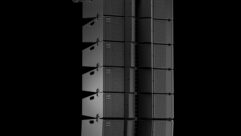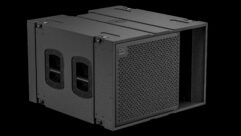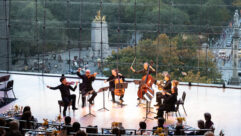Tailored for Sound
Dec 1, 2002 12:00 PM,
Ron Freiheit
Music education and performance spaces have distinct acoustical requirements. The study of music is dependent upon the ability to learn and hear even the most subtle differences in intonation, dynamics, articulation, and balance. This skill, called critical listening, can be developed and honed only in an environment with proper acoustics. This article will describe key acoustical requirements of both environments, including an overview of passive and active acoustical treatments.
REHEARSAL ENVIRONMENTS
In a school, the music rehearsal area must receive special acoustical consideration. The range and quality of sound produced in the music area is vastly different from a traditional classroom, which is designed primarily for speech communication. Musical education needs in terms of frequency and dynamic range of sound is much wider than in conventional classrooms in which speech communication is the primary concern. Certain acoustical characteristics are essential in a rehearsal room, including adequate cubic volume and sound isolation.
Cubic volume
The single most important rehearsal room characteristic for acoustical success is cubic volume. Inadequate cubic volume can make the room unresponsive or excessively loud; those problems may be impossible to completely correct. A good rule of thumb is a minimum of 1,800 square feet of floor space for a choral rehearsal room and at least 2,500 square feet for a band/orchestra rehearsal room. Ceilings should be 16 to 20 feet high in a choral room and 18 to 22 feet high in a band/orchestra room.
Cubic volume and ceiling height are important in providing a sense of acoustical support, or presence, and adequate sound delay. A musician needs to be able to hear his or her own sound as it exists in space, not just at the instrument. The minimum desired delay time is approximately 30 ms (sound travels about one foot per millisecond). For a seated musician in a room with a 20-foot ceiling, the distance from the ears to the ceiling would be 15 feet. The approximate round-trip time for sound waves to return to the ears would be 30 ms.
Music rehearsal spaces call for reverberation times of 0.8 to 1.0 second for a band/orchestra room and about 1.3 seconds for a choral room. The goal is to strike the proper balance between dry and reverberant.
Maintaining cubic volume is a definite advantage of using portable risers rather than poured concrete when tiered flooring is desired. The space beneath portable risers, if left open, will not reduce the room’s cubic volume. In a similar way, instrument storage cabinets located within the rehearsal room should have grille-front doors because they will not reduce a room’s cubic volume. Those doors also help improve sound diffusion in the room.
Along with negative educational effects, prolonged exposure to excessively loud rooms can cause permanent hearing loss among teachers and students.
Sound isolation
Good sound isolation effectively blocks the transmission of sound from one room to another. All walls in the music rehearsal area should be full height, from the floor to the roof deck, including airtight seals to the building structure. Rehearsal rooms and practice rooms should be separated by buffer zones, such as corridors or storage rooms. For optimum results, the entire music area should also be buffered from adjacent areas of the school, such as gymnasiums, machine and woodworking shops, and cafeterias.
Within the rehearsal room, the number of door and windows should be kept to a minimum to reduce sound leakage; ideally, any doors or windows should have acoustical ratings similar to the wall construction. Care must also be taken so that disruptive noise from fluorescent lighting ballasts or HVAC systems do not mask the music being created.
Wall and ceiling shapes
These play a crucial role in room acoustics because they determine how sound will be reflected and diffused within the environment. Untreated parallel wall surfaces can cause undesirable flutter echoes and standing waves, in which certain frequencies become overemphasized. To minimize standing waves, avoid parallel walls in the horizontal plane and vertical plane. Questions about wall and ceiling shapes in rehearsal rooms are best addressed by a professional acoustician with experience in music education facilities.
Passive acoustical treatments
Passive acoustical treatments use specially designed panels to affect the acoustics in a room. Absorption and diffusion panels mounted on the walls and ceilings help balance the way sound is absorbed and distributed within the treated environment. The goal is to create a balanced, blended sound that can be heard by everyone in the space while keeping the dynamics in a comfortable range.
The necessity of a blended, holistic sound is a key difference that distinguishes the music rehearsal room from a regular classroom. Although a lecture hall requires some acoustical reflection, a music rehearsal room requires excellent cross-communication. Musicians on one side of the ensemble need to hear sounds from the other side, and the director should be able to hear a balanced sound from the entire group.
Music educators who experience the benefits of acoustical panels notice the difference immediately. “The acoustical panels are fantastic — I would never teach without them again,” says Eric Harris, the band director and music department chair at Vance High School in Charlotte, North Carolina. “The ensemble balance and blend are better with the panels, and we don’t have as many pitch problems. After teaching all day, my ears don’t have nearly the fatigue they did before, when I taught without panels.”
Every surface in the rehearsal room environment has a direct effect on how sound and acoustics work within the environment. A common misconception is to rely on room-finishing materials — such as carpet, drapes, and upholstery — to absorb sound. Those materials typically absorb higher frequencies only, leaving lower ones unaffected. That means music from high-frequency instruments like flutes or violins can be lost. The resulting imbalance accentuates the lower frequencies, such as tubas, drums, or basses.
To absorb a wide frequency range, absorber panels are constructed of thick, compressed fiberglass. The thicker the fiberglass, the lower the frequency it can absorb. Three-inch fiberglass is a good minimum thickness for effective, wide-range absorption of musical frequencies. Diffuser panels are usually made of hard material, such as PVC/acrylic, fiberglass resin, or wood.
Active acoustical treatments
Just as tennis players practice on the tennis court, the best place for musicians to practice is the environment where they’ll be performing. Because school auditoriums and concert halls are used for many activities, it is often inconvenient or impractical for groups or individual musicians to practice there, except for perhaps one or two dress rehearsals. That can put performers at a distinct disadvantage during a concert, when they are experiencing a different acoustical environment. Their own sound and the sounds of other musicians may be unfamiliar.
Active acoustics technology is capable of bridging the gap between rehearsal and performance environments by creating rehearsal spaces that can simulate the acoustics of different environments. Active acoustics use electro-acoustic elements — speakers, microphones, and digital signal-processing (DSP) technology — to positively affect the acoustics of an environment.
Many different systems for electronically enhancing the acoustics of rehearsal and performance spaces are available today; among the best-known systems are the Lexicon LARES, Level Control Systems. These dramatic systems use time-variant DSP to individually control multiple channels of audio that are routed and amplified at specific interval locations in the space.
The speakers selected for this application must have wide dispersion characteristics and must be somewhat nondirectional to simulate an actual acoustic space without allowing the listener to directly identify the source of the sound. Each application of the technology is unique, because no two acoustical spaces are identical. Any space can be adapted theoretically with this technology. However, back in the early ’90s, Wenger approached Lexicon, which was developing the LARES. The results of that collaborative effort led to a project using both passive and active technology to treat a whole rehearsal room. The first installation was finished in fall 2001 at the University of Louisville’s School of Music, located in Louisville, Kentucky.
This particular rehearsal room is a 22-by-25-foot chamber-size room with 12 ceilingmounted speakers and another 12 mounted laterally along the walls. The speaker placement is designed to minimize localization and create a sense of envelopment. The electronic enhancement allows for 13 preset acoustical settings that simulate performance environments ranging in size from a baroque-style recital hall to a large auditorium or cathedral. There are also five additional custom settings that are designed to represent Comstock Concert Hall, the university’s primary concert and recital hall.
The use of active time-variant DSP and amplification to simulate larger acoustical spaces inside smaller rooms is one thing, but there are also numerous examples of this kind of technology being utilized to solve problems in large acoustical spaces, as well. In most cases, it is a combination of passive acoustical treatment and this kind of electronic enhancement that provide the ideal solution. The active enhancement technology becomes an excellent tool in spaces that are architecturally sensitive, because in these kinds of installs, it is usually not possible to add passive treatments without destroying the ambience and original decor of the venue.
Electronic enhancement systems generate direct, reflected, and reverberant energy at the appropriate time and level, enabling a venue to alter and optimize its acoustical characteristics for a wide range of users and performances. This energy can be optimized in each section of the space, providing more uniform listening conditions throughout the entire venue. For example, an electronically enhanced system can deliver greater amounts of direct and early energy to the rear of a large hall or opera house to maintain impact and clarity. Simultaneously, an enhanced system can add more reverberant energy in the front to improve spaciousness and envelopment where listeners are closer to the direct sound of the instruments.
PERFORMANCE ENVIRONMENTS
As in a rehearsal area, the main acoustical concern in an auditorium or any other performance environment is to provide support for musicians. Musicians need to hear their own sound in the space and hear other performers, too. When musicians can’t hear themselves, particularly younger musicians, they lose confidence more easily and, consequently, do not perform as well.
Effective acoustical treatment improves the performance experience for the audience by helping project the music throughout the entire seating area. The optimum reverberation time in a concert hall is about two seconds.
In most performing environments, concerns about sound isolation, wall and ceiling shape, and cubic volume have already been addressed in the facility’s design and construction. The complexity of these projects makes the input of a professional acoustician invaluable. For general background, an excellent resource is Leo Leroy Beranek’s book Concert and Opera Halls: How They Sound, published by the Acoustical Society of America.
The multipurpose nature of most auditoriums — which host a variety of events, including theatrical productions — means they are not optimized for music performances. In particular, the proscenium arch and curtain separating the stage and audience area have the effect of creating two different rooms acoustically. Sound produced onstage is easily trapped there, including above the stage in the fly loft space used to store scenery, curtains, and lighting. Musicians have likened the unfavorable sensation of performing in such an environment to playing with a blanket wrapped around you.
Passive acoustical treatments
The most widely used passive acoustical treatment for an auditorium stage is an acoustical shell, often called an orchestra shell. Several types are available, ranging from small portable models to large full-stage orchestra enclosures consisting of vertical tower sections and suspended ceiling panels that completely seal off the stage area from the back of the house and fly loft.
At the Nancy Lee and Perry R. Bass Performance Hall in Fort Worth, Texas, managing director Paul Beard says the full-stage acoustical shell is flexible enough to radically change the conditions onstage from performance to performance. “Our versatility is a tremendous asset,” says Beard. “Bass Hall is designed to accommodate all of the performing arts without compromising any of them.”
Most acoustical shells offer options for tuning and adjustability, including the number of panels used and their placement. If there is a large performing group onstage, for example, the shell’s tower sections may be spaced apart slightly to release excess sound pressure to the backstage area.
Beard says the shell’s acoustics have generated positive feedback from performers. “Not only are [the musicians] able to hear their own instruments, but they also can hear each other,” says Beard. “It’s a less forgiving climate for mistakes, inspiring performers to perform at their utmost, and the audience is rewarded.”
Along with improving acoustics, a shell can complement an auditorium’s appearance, too. “Visually, our shell is sublime,” says Beard. “It brings a certain refinement and sophistication — a visual harmony — that supports the creative process onstage.”
J. S. Bradley wrote an evaluation of acoustical shells that was published in the August 1996 edition of The Journal of the Acoustical Society of America. For his study, Bradley took acoustic measurements in three large multipurpose performance halls, each with a different type of acoustical shell. Measurements were taken with and without the acoustical shell in place. The three shells ranged from just a proscenium wall to a complete enclosure.
On average Bradley’s measurements indicated that an acoustical shell increased sound levels in the audience area from 1.5 dB to 2.0 dB. That is roughly equivalent to increasing the size of the orchestra by 50 percent. The larger the shell, the larger the acoustical benefit. When sound levels onstage were evaluated, a shell’s influence was even stronger, increasing sound levels for musicians by approximately 5 dB.
To help balance the acoustics throughout the audience area, acoustic-design professionals often specify that diffuser panels are placed on the sidewalls in the front third of the auditorium and suspended over the audience. The panels, often called clouds, help improve sound projection to the audience.
On the middle third of each sidewall, a combination of diffusion and absorption panels is often recommended, with the rear third of sidewalls usually covered primarily with absorber panels. The back wall of the auditorium is usually treated with a combination of absorber and diffuser panels to eliminate any hard reflections directly back to the stage. If there is a balcony with a large front surface, this area should be treated with diffusion or absorption panels, depending on the existing acoustics in the room. Without proper treatment, this large reflective surface can create a slapback effect for musicians onstage.
To optimize music education and performance spaces, acoustical treatments must support critical listening by musicians in rehearsal environments and by musicians and the audience in performance settings. The proper use of acoustical treatments — passive, active, and combinations of both types — is essential to a successful facility.
Ron Freiheit is the manager of acoustics research for the Wenger Corp. He can be reached at [email protected].










